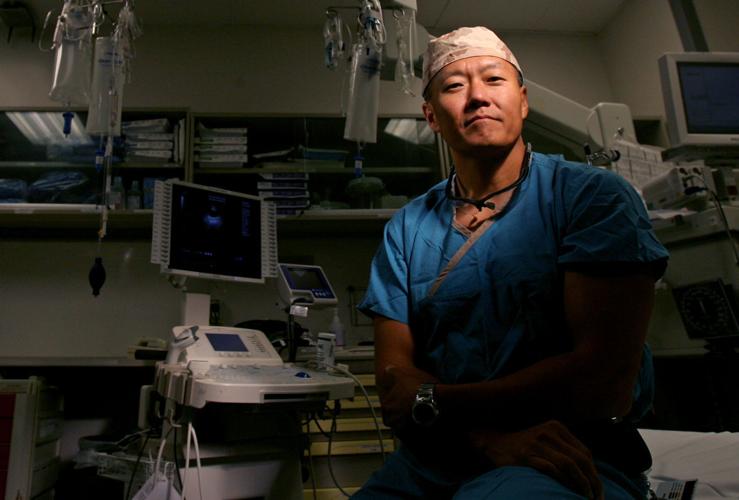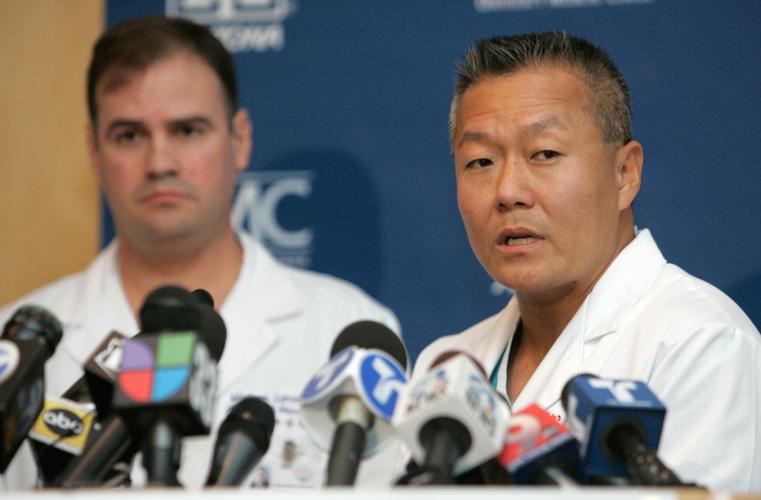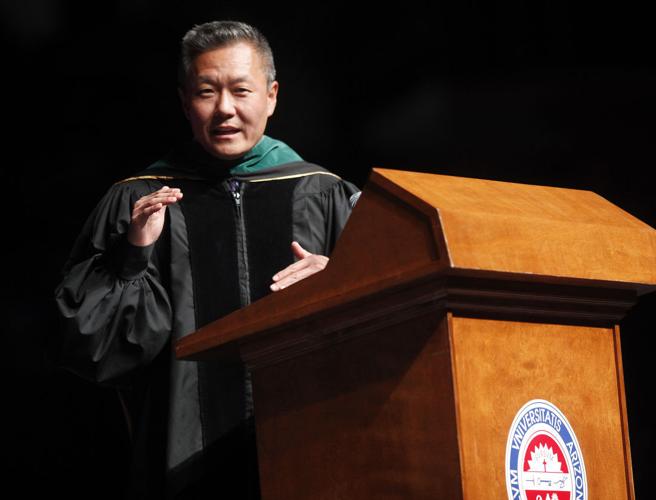Politics and a recent hospital merger fueled a decision by top trauma surgeon Peter Rhee to leave Tucson for Atlanta, he confirmed Thursday.
Rhee, who was dubbed a “rock star surgeon” by the media for his care of victims of the Jan. 8, 2011, mass shooting, says he has hit a wall at Banner-University Medical Center Tucson and it’s time to leave. His last day will be June 20.
His new job will be senior vice president of acute care surgery and medical director of the Marcus Trauma Center at Grady Memorial Hospital in Atlanta, which treats a large number of low-income people and is the fifth largest public hospital in the country.
In Tucson, Rhee is a tenured surgery professor at the University of Arizona with an endowed $2 million chair and also chief of trauma, critical care, burn and emergency surgery at Banner-UMC.
“I love Tucson so much. Its greatest asset is its people. I am so sad I have to leave,” the South Korean-born surgeon said in an interview. “But I can’t stay in a place and play defense all the time.”
In a joint emailed statement, the UA and Banner Health said they had hoped Rhee would remain in Tucson and praised his “tireless efforts” to build a trauma care and training program, “and for creating a legacy that will benefit patients and students for years to come.”
True leaders build sustainable programs and that is what Rhee did, the statement says.
Merger woes
A merger last year left Phoenix-based nonprofit Banner Health in control of the hospital and added a layer of bureaucracy that slowed progress and shifted priorities away from research, Rhee said.
“I don’t think the UA is necessarily unique but in health care right now, focus is away from academics. The primary area of concern in medicine right now is going to be just about making money for the hospital and away from research and development,” Rhee said.
“They want everything. They want the icing but the focus is making money to go forward. I need to be in an academic environment.”
Banner officials and the UA responded Thursday that they are committed to growing both the academic and clinical aspects of the trauma program.
Rhee, a former battlefield surgeon with the U.S. military, also was saddened by the 2013 suspension and subsequent departure of Dr. Rainer Gruessner, the former department of surgery chair, he said. Gruessner recruited Rhee to revive a flailing trauma program in 2007. At that time the hospital was called University Medical Center.
Gruessner, who is credited with expanding and improving the hospital’s transplant and trauma programs, left amid a bitter political dispute with the administration that preceded last year's merger.
Until Gruessner’s departure, Rhee said he’d always assumed he’d be in Tucson for the rest of his career. He has had 32 addresses in his life and the one where he’s stayed the longest is here.
For a long time, Tucson was a good fit, said Rhee, who came to Southern Arizona from the Los Angeles County and the University of Southern California Navy Trauma Training Center, where he prepared Navy doctors and medical personnel for the battlefield. He saw the Tucson job as a challenge.
“I was a very loyal supporter of Dr. Gruessner and I think he got shafted,” Rhee said. “It ended with no one but losers ... I’ve done as much as I can in this particular program.”
Rhee said the Grady trauma program is twice the size of the one in Tucson and gives him a new challenge.
“I’ve always considered my work public service,” Rhee said. “They recruited me heavily for a long time now. It is a county hospital working with inner-city people as well as taking care of entire metropolitan Atlanta.”
Tucson program
was struggling
Rhee first came to Tucson in 2007 to help revive the hospital’s struggling trauma program.
“The program was in disarray, the funding was a major issue and almost all the staff had left — which to me looked like an opportunity,” Rhee recalled in his 2014 memoir, “Trauma Red: The Making of a Surgeon in War and in America’s Cities.”
In that book, Rhee wrote that building up the local trauma program wasn’t easy. The only top-level trauma center in Southern Arizona, Banner-UMC handles about 5,000 patients per year whose injuries range from gunshot wounds to car crash injuries. It wasn’t unusual for him to work 120-hour weeks, he wrote.
Rhee and Gruessner brought a research focus to the surgery department, with Rhee focusing, among other things, on gunshot wounds and on a last-ditch lifesaving method called suspended animation that involves bringing patients’ bodies down to hypothermic temperatures by infusing a refrigerator-cold solution into their veins.
Data from a peer-reviewed study published in the Journal of the American College of Surgeons shows that under Rhee, the survival rate of people treated at the local trauma center who had been shot in the brain rose from 10 percent to nearly 50 percent in five years.
Rhee took an approach of “aggressive management” of such cases — an approach that some question because some of the people who survive do not go on to have meaningful lives.
He used aggressive interventions on Gabrielle Giffords, the former U.S. congresswoman who was treated at the trauma center after she was shot in the head during an assassination attempt on Jan. 8, 2011.
“You don’t know who is going to live and die,” Rhee told the Star in 2014. “You don’t want me as a physician to be judge and jury. … Any time you touch any part of the brain, technically there is a deficit, obviously. But a lot of those things you can overcome. And Gabby is not the only person who has survived in her same fashion.”
The evening of the shooting, after Giffords had part of her skull removed, Rhee used a device on her that cools the skin. Cooling the body is counterintuitive care for trauma patients, who are normally kept warm to help blood clot.
“In January 2011 when Gabby Giffords got shot, a lot of people say she got lucky. I think it’s because of what we had in place at that time,” Rhee said in 2014.
At Grady, Rhee will be going back into more academia and research, he says, working with two medical schools — Emory University School of Medicine and the Morehouse School of Medicine.
Jan. 8, 2011
Giffords and 10 other victims were brought to the hospital the day of the mass shooting.
Gruessner had recruited four of the six lead physicians who treated the Jan. 8 victims. Dr. Michael Lemole performed surgery on Giffords and, along with Rhee, became a household name, with some media dubbing them “rock star surgeons.”
Rhee earned a reputation for no-nonsense candor in his many appearances in print and broadcast media and also got some laughs for his phone ringtone: The Bee Gees’ “Stayin’ Alive.”
He has since become outspoken about guns and the devastating injuries they are causing and addressed the issue in his book.
In 2014, Rhee and his colleagues published a study in the Journal of Acute Care Surgery that found that children are safer in states with strict firearm legislation. Arizona was not one of the 11 states with strict firearms legislation.
“It is pretty straightforward that the laws do make a difference,” Rhee said at the time.
3rd trauma surgeon
to depart in 5 months
“We are extremely excited to have a surgeon of Dr. Rhee’s extraordinary talents and experience join the Grady medical leadership team,” Dr. Robert Jansen, executive vice president, chief medical officer and chief of staff at Grady Health System, said in a prepared statement.
Rhee says he hopes Banner does a national search to fill his post. He says he will be the third trauma surgeon to leave Banner-UMC in the last five months and that more may be leaving shortly.
“I feel like I am abandoning the town I love. Tucson has been so good to me and the people have been so generous,” he said. “While a few people resistant to change have made it politically difficult for me here in the last few years, I love Tucson with all my heart and will always call it home.
“I know that am leaving the trauma center here a better place than I found it. I will really miss the people that I have been privileged to have worked with and for. Trauma is a public service.”








